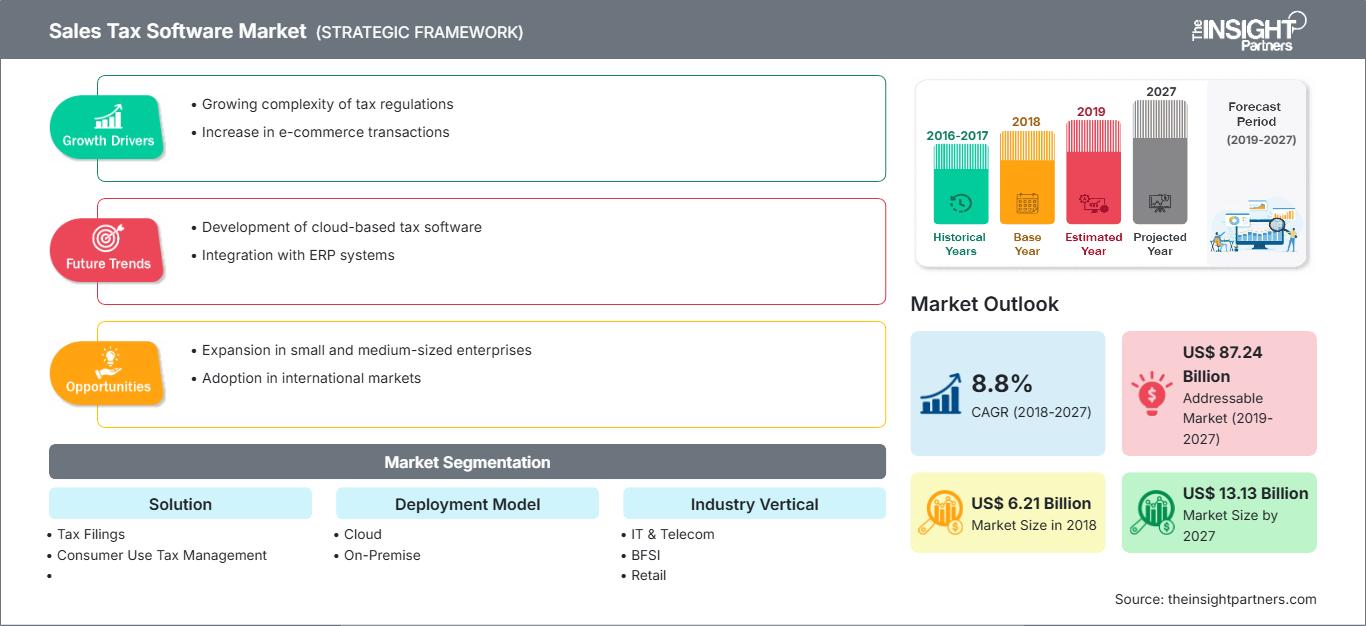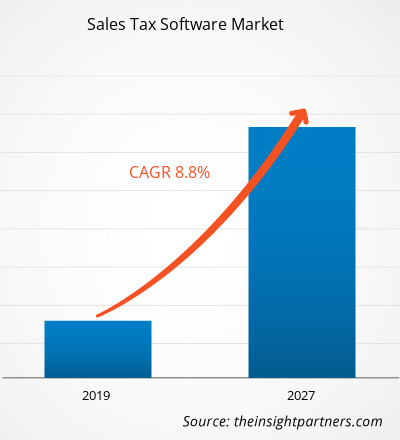[Rapporto di ricerca]Il mercato dei software per l'imposta sulle vendite ha rappresentato 6,21 miliardi di dollari nel 2018 e si prevede che crescerà a un CAGR dell'8,8% nel periodo di previsione 2019-2027, fino a raggiungere i 13,13 miliardi di dollari entro il 2027.
Tra le varie regioni geografiche, il Nord America è stato il principale mercato dei software per l'imposta sulle vendite e si prevede che sarà il maggiore contributore di fatturato durante il periodo di previsione. La crescita e l'adozione nel mercato nordamericano dei software per l'imposta sulle vendite sono trainate principalmente dalla crescente domanda di software per l'imposta sulle vendite da parte di vari settori come vendita al dettaglio, IT e telecomunicazioni, trasporti e sanità, tra gli altri.
Approfondimenti di mercato: attenzione all'aggiornamento costante di leggi e regolamenti fiscali in tutto il mondo
L'imposta sulle vendite e le imposte indirette sono importanti fonti di entrate per i governi e leggi fiscali efficienti e complesse aiutano le autorità a riscuotere il massimo gettito fiscale. Con l'aumento del commercio transfrontaliero e della vendita al dettaglio online in tutto il mondo, unito alle ultime tendenze come l'e-commerce e la digitalizzazione, le autorità fiscali di tutto il mondo aggiornano costantemente le proprie leggi e normative fiscali per tenere conto dei recenti sviluppi nei mercati globali. L'effetto delle modifiche alle leggi e alle normative fiscali è incerto e dipende da molteplici fattori, pertanto le aziende devono investire ingenti risorse per comprendere e sviluppare i propri calcoli per la determinazione dell'imposta sulle vendite. Con il coinvolgimento umano, esiste un elevato rischio di perdere dettagli importanti, il che potrebbe comportare errori di calcolo e sanzioni da parte delle autorità. Le grandi imprese hanno compreso questa esigenza e stanno investendo nell'automazione della determinazione dell'imposta sulle vendite e del processo di dichiarazione al fine di ridurre il rischio di errore umano; tuttavia, le piccole e medie imprese sono ancora in fase di adattamento all'idea di automazione e digitalizzazione. Pertanto, si prevede che la continua evoluzione delle leggi e delle normative fiscali guiderà la futura crescita del mercato dei software per la determinazione dell'imposta sulle vendite.
Personalizza questo rapporto in base alle tue esigenze
Potrai personalizzare gratuitamente qualsiasi rapporto, comprese parti di questo rapporto, o analisi a livello di paese, pacchetto dati Excel, oltre a usufruire di grandi offerte e sconti per start-up e università
Mercato del software per l'imposta sulle vendite: Approfondimenti strategici

-
Ottieni le principali tendenze chiave del mercato di questo rapporto.Questo campione GRATUITO includerà l'analisi dei dati, che vanno dalle tendenze di mercato alle stime e alle previsioni.
Questa rivoluzione della digitalizzazione in tutto il mondo offre un'enorme opportunità per le aziende di utilizzare servizi digitali e automazione per trasformare i propri modelli di business e i processi esistenti, aumentando l'efficienza operativa e i ricavi. La trasformazione digitale, o digitalizzazione delle aziende, consiste essenzialmente nell'integrazione della tecnologia digitale in vari processi aziendali, attività organizzative e modelli di business. L'ottimizzazione dei processi aziendali end-to-end, l'efficienza operativa, la riduzione dei costi e degli errori umani sono alcuni dei principali motori della trasformazione digitale in qualsiasi settore. Il passaggio di paradigma delle aziende dai processi tradizionali a quelli digitali e automatizzati ha portato molteplici vantaggi, che vanno dal miglioramento dell'efficienza alla riduzione dei costi e all'aumento delle opportunità di fatturato. Oltre a ciò, i progressi tecnologici nel cloud computing e nelle tecnologie di storage, nonché la potenza delle piattaforme basate su cloud, sono aumentati esponenzialmente nell'ultimo decennio. Ciò ha ulteriormente creato nuove opportunità per le aziende di optare per software per l'imposta sulle vendite basato su cloud.
Approfondimenti sui componenti
Il mercato globale dei software per l'imposta sulle vendite per componente è stato guidato dal segmento delle soluzioni per la determinazione e la presentazione delle imposte. Le soluzioni di gestione dei documenti di conformità hanno detenuto la seconda quota di mercato più grande nel software per l'imposta sulle vendite nel 2018 e si prevede che aumenteranno la loro quota nel periodo di previsione dal 2019 al 2027.
Approfondimenti sul tipo di implementazione
Il mercato globale del software per l'imposta sulle vendite, per tipo di implementazione, è stato guidato dal segmento cloud. Le aziende sono più propense a utilizzare software per l'imposta sulle vendite basati su cloud, poiché la dichiarazione dei redditi viene automaticamente sottoposta a backup su server sicuri. Il software basato sul cloud consente alle aziende di espandersi rapidamente senza dover effettuare investimenti significativi nella propria infrastruttura tecnologica, poiché le tecnologie cloud sono estremamente adattabili ai rapidi cambiamenti. Si adattano anche ad ambienti normativi e di reporting dinamici.
Approfondimenti sul settore verticale
Il mercato globale del software per l'imposta sulle vendite è segmentato per settore verticale, tra cui BFSI, vendita al dettaglio, IT e telecomunicazioni, trasporti, sanità e altri. Nel 2018, il settore retail ha detenuto la quota di fatturato maggiore nel mercato globale dei software per l'imposta sulle vendite e si prevede che manterrà la sua posizione dominante nel periodo di previsione dal 2019 al 2027. Gli altri utenti finali del mercato dei software per l'imposta sulle vendite includono energia, produzione, istruzione e ospitalità.
Gli operatori presenti nel mercato dei software per l'imposta sulle vendite si concentrano principalmente sul miglioramento dei prodotti attraverso l'implementazione di tecnologie avanzate. La stipula di partnership, contratti, joint venture, finanziamenti e l'inaugurazione di nuove sedi in tutto il mondo consentono all'azienda di mantenere il proprio marchio a livello globale. Di seguito sono elencati alcuni dei recenti sviluppi nel mercato globale dei software per l'imposta sulle vendite:
2019: Sovos Compliance e Tytho hanno firmato un accordo di partnership strategica per rafforzare la posizione di leadership fiscale e anche per supportare l'implementazione delle soluzioni Sovos Compliance e promuovere il suo prodotto. 2017: TaxJar ha chiuso un round di finanziamento di Serie A da 60 milioni di dollari da Insight Venture Partners. Il finanziamento più recente di 2 milioni di dollari è stato guidato da Rincon Venture Partners e Daher Capital nel 2014. Il finanziamento consentirebbe all'azienda di concentrarsi sullo sviluppo dei prodotti e sulle strategie di sviluppo aziendale. 2018: Ryan ha ampliato la portata dell'alleanza con Avalara per fornire servizi di consulenza alle aziende di carburante per motori che desiderano cambiare i sistemi ERP per ottenere una determinazione e una rendicontazione fiscale efficienti.
Approfondimenti regionali sul mercato dei software per l'imposta sulle vendite
Le tendenze regionali e i fattori che influenzano il mercato del software per l'imposta sulle vendite durante il periodo di previsione sono stati ampiamente spiegati dagli analisti di The Insight Partners. Questa sezione illustra anche i segmenti e la geografia del mercato del software per l'imposta sulle vendite in Nord America, Europa, Asia-Pacifico, Medio Oriente e Africa, America meridionale e centrale.
Ambito del rapporto di mercato del software per l'imposta sulle vendite
| Attributo del rapporto | Dettagli |
|---|---|
| Dimensioni del mercato in 2018 | US$ 6.21 Billion |
| Dimensioni del mercato per 2027 | US$ 13.13 Billion |
| CAGR globale (2018 - 2027) | 8.8% |
| Dati storici | 2016-2017 |
| Periodo di previsione | 2019-2027 |
| Segmenti coperti |
By Soluzione
|
| Regioni e paesi coperti |
Nord America
|
| Leader di mercato e profili aziendali chiave |
|
Densità degli operatori del mercato del software per l'imposta sulle vendite: comprendere il suo impatto sulle dinamiche aziendali
Il mercato dei software per la gestione delle imposte sulle vendite è in rapida crescita, trainato dalla crescente domanda degli utenti finali, dovuta a fattori quali l'evoluzione delle preferenze dei consumatori, i progressi tecnologici e una maggiore consapevolezza dei vantaggi del prodotto. Con l'aumento della domanda, le aziende stanno ampliando la propria offerta, innovando per soddisfare le esigenze dei consumatori e sfruttando le tendenze emergenti, alimentando ulteriormente la crescita del mercato.

- Ottieni il Mercato del software per l'imposta sulle vendite Panoramica dei principali attori chiave
- Determinazione dell'imposta e Soluzioni di archiviazione
- Soluzioni di gestione dei documenti di conformità
- Servizi
Per tipo di distribuzione
- Cloud
- On-Premise
Per settore verticale
- BFSI
- IT e telecomunicazioni
- Vendita al dettaglio
- Sanità
- Trasporti
- Altri
Per area geografica
-
Nord America
- Stati Uniti
- Canada
- Messico
-
Europa
- Francia
- Germania
- Regno Unito
- Russia
- Italia
- Resto d'Europa
-
Asia Pacifico (APAC)
- Corea del Sud
- Cina
- India
- Giappone
- Australia
- Resto dell'APAC
-
Medio Oriente e Africa (MEA)
- Arabia Saudita
- Sudafrica
- EAU
- Resto del MEA
-
Sud America (SAM)
- Brasile
- Argentina
- Resto del SAM
Profili aziendali
- APEX Analytix
- Avalara, Inc.
- Ryan, LLC
- The Sage Group Plc
- Sovos Compliance LLC
- Taxjar
- Thomson Reuters Corporation
- Vertex, Inc.
- Wolters Kluwer (CCH Incorporated)
- Xero Limited
- Analisi storica (2 anni), anno base, previsione (7 anni) con CAGR
- Analisi PEST e SWOT
- Valore/volume delle dimensioni del mercato - Globale, Regionale, Nazionale
- Industria e panorama competitivo
- Set di dati Excel
Report recenti
Rapporti correlati
Testimonianze
Motivo dell'acquisto
- Processo decisionale informato
- Comprensione delle dinamiche di mercato
- Analisi competitiva
- Analisi dei clienti
- Previsioni di mercato
- Mitigazione del rischio
- Pianificazione strategica
- Giustificazione degli investimenti
- Identificazione dei mercati emergenti
- Miglioramento delle strategie di marketing
- Aumento dell'efficienza operativa
- Allineamento alle tendenze normative






















 Ottieni un campione gratuito per - Mercato del software per l'imposta sulle vendite
Ottieni un campione gratuito per - Mercato del software per l'imposta sulle vendite